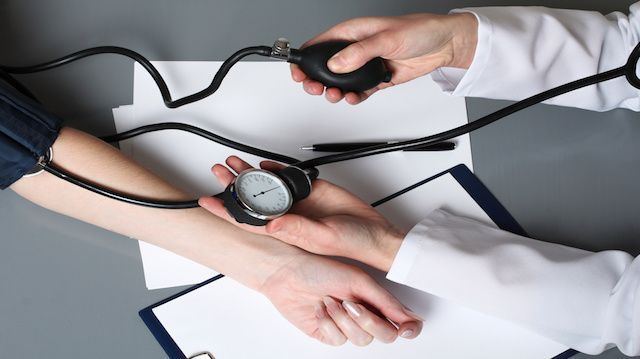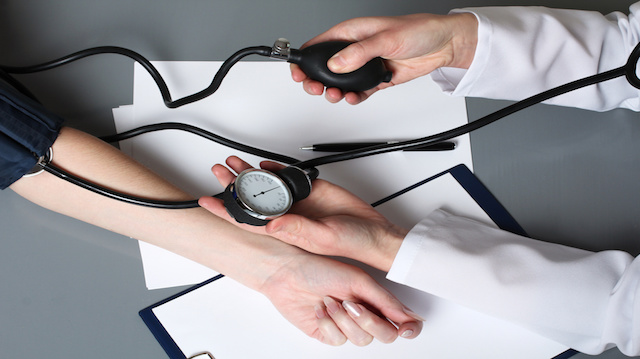
As a society, our collective blood pressure is rising at an alarming rate. In 2013, about one in every three American adults had high blood pressure. By 2030 this already sky-high figure is expected to increase a further 7.2 percent.
Currently another one in three U.S. adults (on top of those already diagnosed) have prehypertension, which is elevated blood pressure but not yet in the range for formal diagnosis.
By the time the average American reaches age 65, they have a 90 percent expectancy of developing high blood pressure. High blood pressure as a widespread public health phenomenon is estimated to cost the United States over 51 billion dollars per year.
On its own, high blood pressure can cause a range of symptoms and discomforts, but it is also a major precursor for life-threatening conditions such as heart disease and stroke. It is a contributing factor and precursor to some of the leading causes of death in North America.
Depending on your perspective, you may view high blood pressure as a detestable disease that is plaguing helpless Americans. All we can do in this case is prescribe medications to lower blood pressure to ever greater segments of the population, and hope for the best.
Conventional blood pressure treatment
Typically blood pressure is treated with a variety of medications, which can include diuretics, alpha and/or beta blockers, angiotensin hormonal manipulators, calcium channel blockers, nervous system inhibitors and vasodilators.
It’s common for more than one of the following medications to be prescribed concurrently, so a person may experience several side effects:
Diuretics flush extra water and sodium from the body. Possible side effects are frequent urination, erectile dysfunction, weakness, leg cramps, fatigue and gout.
Beta-blockers make your heart beat with less force and at a lower rate. Side effects include asthma symptoms, cold hands and feet, depression, erectile dysfunction, insomnia and sleep problems.
Angiotensin converting enzyme (ACE) inhibitors block formation of the hormone angiotensin, which causes blood vessels to narrow. Side effects of these drugs include a persistent dry, hacking cough, skin rash and a reduced sense of taste.
Calcium channel blockers (CCBs) keep calcium from entering the heart muscle and blood vessel cells. Common side effects are constipation, dizziness, headache, palpitations and swollen ankles.
These medications are often prescribed before a full diagnosis of high blood pressure in an effort to hold off the progression of the condition. Unfortunately, in the case of prehypertension, there is little evidence that the medications are effective.
You can control blood pressure naturally
Luckily, if you have been warned of high blood pressure, consuming a pile of pills every day is not necessarily your fate.
Consider this eye-opening fact: Research shows that high blood pressure affects only about three percent of people in societies where an ancestral diet and lifestyle are still practiced. This suggests that high blood pressure is an illness resulting from poor nutrition and general health practices.
Indeed, studies show that hunter-gatherers who adopt a typical Western lifestyle can rapidly develop chronic diseases such as high blood pressure, and vice versa: people with high blood pressure can reverse the condition by committing to an improved lifestyle.
This suggests that the root causes of high blood pressure are related to self-imposed conditions: nutrient deficiencies, consumption of processed food, inflammation of the body, and poor lifestyle practices.
Although improving blood pressure through diet changes is entirely achievable and really quite simple, one cannot deny that it takes a considerable amount of dedication. The good news is, results can be seen very quickly after adopting a few simple blood-pressure-friendly practices.
Dietary tips to control blood pressure
Clinical studies have found that a nutrient-dense, real-food diet is the best approach for balanced blood pressure. This is very much in line with what we generally recommend here at The Alternative Daily. The following is a concise and actionable plan to remodel your eating so that you can start feeling better fast.
The first step toward healthier blood pressure is to remove processed foods and sweetened beverages. Anything packaged, prepared or preserved tends to contain a host of substances that are harmful to your blood pressure. The worst offenders are sugar, sodium and trans fats, which throw the body out of whack and leave it sick and inflamed.
Notice how we said “sodium,” not salt? That’s because salt has been wrongly targeted as one of the culprits behind the high blood pressure epidemic. Natural, unprocessed salts are perfectly healthy for the human body, and are even critical for survival. We recommend pink Himalayan salt, the Real Salt brand, which is harvested from prehistoric oceans, or Celtic Grey sea salt. These natural salts contain over 80 important trace minerals, which accompany the sodium and help the body use and process salt in a healthy way.
So step two is to make the simple swap to whole salt rather than purified table salt. This will allow you to consume vital minerals and enjoy flavorful food. Eating healthily doesn’t have to be bland or boring — in fact, it can be considerably more delicious!
Step three is undoubtedly to increase the intake of fresh produce. Organic is best, but any fruits and veggies are better than none! Focus on produce that is high in potassium and magnesium, since these are two minerals we commonly lack. Increasing both potassium and magnesium has been shown to dramatically improve blood pressure.
Some foods to include are sweet potatoes, plantains, halibut, salmon, spinach, nuts and extra-dark chocolate. Also include healthy herbs and seasonings, such as fresh garlic, which is known to have a blood pressure-reducing effect.
Next up — step four — toss the junky processed animal products and factory-farm raised meats. It doesn’t cost much more to invest in good quality organic and free-range proteins. The chemical composition of free-range animal meat is entirely different than the meat from animals raised in intensive farming operations. Grass-fed beef, for example, is an excellent source of both omega-3 fatty acids and magnesium, both of which are helpful in reducing blood pressure. Cold-water fish such as mackerel, salmon and sardines are also excellent choices since their omega-3 content is anti-inflammatory.
Step five, leading on from the healthy oily fish, we also want to add in healthy fats. Although the conventional approach is to limit and reduce fat, we assert that natural minimally processed fats are vital for a healthy diet. Fats help to metabolise the vitamins and minerals from the other foods that you eat, and provide raw materials for making hormones and cells. They are highly satiating, meaning that they help you feel satisfied after a meal. Good fats to consume are avocados, coconut oil, cold-pressed extra-virgin olive oil, and red palm fruit oil.
Step six: Now that you’re consuming so much wholesome real food, which is nourishing and satisfying, it’s time to drop the last items that might be harming your blood pressure levels. These are grains and dairy products.
While mainstream nutritional recommendations are heavy on whole grains (recommending six to eight servings per day) and low-fat dairy, we want to point out that these guidelines are based largely on outdated information. Upon investigating more recent clinical research, it becomes clear that grains and dairy are foods that commonly cause inflammation.
 Holistic health practitioners state that they observe dramatic drops in blood pressure when patients eliminate these two problem foods from their diet. Focus on enjoying those healthy proteins, nourishing fats, and colorful fruits and vegetables, and you will forget you ever wanted to eat grain or dairy products!
Holistic health practitioners state that they observe dramatic drops in blood pressure when patients eliminate these two problem foods from their diet. Focus on enjoying those healthy proteins, nourishing fats, and colorful fruits and vegetables, and you will forget you ever wanted to eat grain or dairy products!
Lifestyle factors to reduce blood pressure
While getting your diet in line is vital, there are other daily habits that will go a long way to reducing your blood pressure.
Getting enough sleep is probably the most important. Exercise and sunlight during the day is a great way to ensure a solid, restful sleep. Taking an Epsom salt bath at night and limiting exposure to electronic devices before bedtime is also conducive to better sleep.
Limiting or entirely avoiding alcohol and caffeine would be wise, at least until you have your blood pressure under control. These substances can be toxic, especially if your body is struggling to maintain balance.
Finally, incorporate simple relaxation practices such as deep breathing, meditation or yoga into your day. Even a five- or 10-minute session each day can make a huge difference to your blood pressure over time. You don’t need to be flexible or a zen monk to use these valuable anti-stress techniques — simply focus on your body, breathe deep into your belly, and calm your mind. It takes a little practice, but you’ll have it down pat in no time.
Don’t let your blood pressure control you — take the reins and create better health for yourself, starting today! Looking for the next step? Try some easy healthy recipes or stress relief techniques!
—Liivi Hess
Liivi is an Integrative Nutrition Health Coach and is training to become a doula. She inspires women to find peace and personal power by taking control of health and fertility naturally. Liivi‘s passion is ancestral nutrition and primal lifestyle design. She and her partner Will live between Toronto, Canada and Queenstown, New Zealand.
Sources:
http://www.ncbi.nlm.nih.gov/pubmed/22895954
http://archinte.jamanetwork.com/article.aspx?articleid=617401
http://jama.jamanetwork.com/article.aspx?articleid=196589&resultclick=1
http://archinte.jamanetwork.com/article.aspx?articleid=485390
http://www.mayoclinic.org/diseases-conditions/high-blood-pressure/in-depth/high-blood-pressure/art-20046974
http://www.cdc.gov/dhdsp/data_statistics/fact_sheets/fs_bloodpressure.htm
http://my.clevelandclinic.org/health/diseases_conditions/hic_Hypertension_High_Blood_Pressure/hic_High_Blood_Pressure_and_Nutrition
http://pmid.us/22615114
http://hyper.ahajournals.org/content/60/1/25
http://pmid.us/22895954
http://www.ncbi.nlm.nih.gov/pubmed/22615114?dopt=AbstractPlus
https://www.nhlbi.nih.gov/files/docs/public/heart/hbp_low.pdf
http://www.ncbi.nlm.nih.gov/pubmed/23414424
http://www.ncbi.nlm.nih.gov/pubmed/19604407

